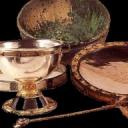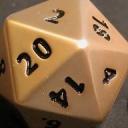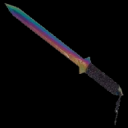Whole Grain Games returns! Eight years is a fairly long time. I’ll be posting various items and such I’ve worked up for Dnd 3.5/3.PF. However many of these concepts and items can be easily translated to 4E or 5E.
Description: One of the most powerful dwarven metals, adamantine is delved from the heart of the world by talented dwarven runemasters. It is so hard it cannot be worked without magic. The shadowy sorcery necessary to work the ore permanently affects the metal, imbuing it with spiritual powers.
Two example items crafted from shadowy adamantine:
| Hale shadowy adamantine shirt This beautiful and dark forgemail +1 (chainmail class, +9 AC, +1 enhancement, total +10) has the ghost touch and sour attributes, and confers fast healing 2 to the wearer. (Sour: Any creature vulnerable to poison becomes dazed for one round after dealing damage with a bite attack. The wearer cannot be held in the mouth of a creature, nor can they be swallowed whole.) |
| Bloody blade The bloody blade is a dark and twisted shadowy adamantine blade. It is appears jagged and poorly cared for with a warped edge; in the light it has a distinctive reddish glint. This blade is nearly intelligent and has a very powerful drive for blood. When handled the wielder can feel its throbbing need to taste living blood. This sword functions as a shortsword +3, has a critical threat range of 18-20 and a multiplier of x3. This weapon allows one re-roll per attack to overcome a miss chance due to cover, concealment, invisibility, blinding effects, blur, etc. The Bloody Blade is wounding 3 (opponents who can bleed take 3 point of damage every round from each hemorrhaging wound) and vicious: it inflicts 2d6 extra damage and 1d6 damage on the wielder with every successful strike. When drawn, it confers a +2 morale bonus versus fear and hold effects. No creature’s damage reduction applies against the Bloody Blade. If the wielder has killed a creature with levels equal to the wielder’s minus two or higher within 24 hours with this blade, they receive a +2 morale bonus to hit. This blade cannot be sheathed without drawing the blood of an intelligent or monstrous creature. The wielder may intentionally cut themselves (or another willing subject), dealing 4d20 damage. If the wielder chooses to draw no blood, the sword cannot be sheathed or set down, and deals 1d6 Con and Wis damage per hour to whomever drew the sword last. |








 RSS Feed
RSS Feed